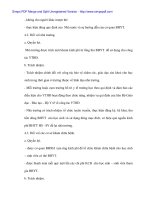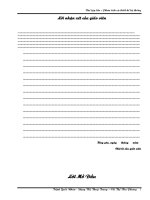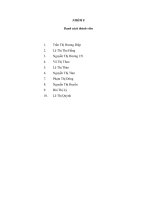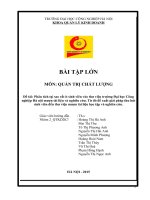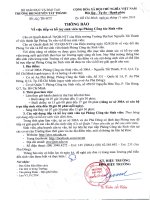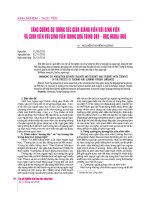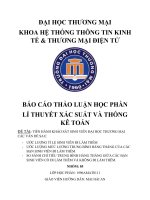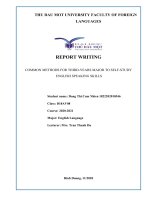một số khác biệt giao văn hóa úc việt trong cách xưng hô của sinh viên với giáo viên
Bạn đang xem bản rút gọn của tài liệu. Xem và tải ngay bản đầy đủ của tài liệu tại đây (381.77 KB, 69 trang )
Vietnam national university - hanoi
College of foreign languages - Post-graduate department
------***------
trần thị thanh bình
Some Australian-Vietnamese crosscultural differences in student-toteacher addressing
(Một số khác biệt giao văn hoá úc việt trong
cách xng hô của sinh viên với giáo viên)
Field:
Linguistics
Code:
50409
Course:
K11
M.A minor - thesis
Supervisor: Assoc. Prof. Dr. NguyÔn Quang
Hai Phong, July 2005
M.A. thesis
Acknowledgements
I wish to thank Assoc. Prof. Dr. Nguyen Quang, my supervisor, for his constant help
throughout the study.
I am indebted to all my lecturers in Vietnam National University, Hanoi, Post Graduate Department for their lectures that enabled me to write this study.
Also I would like to thank Australian and Vietnamese colleagues and friends who
spent their precious time completing the questionnaires.
I wish to thank my cousin, Tran Viet Cuong, who is living and studying at Sydney
University, NSW for his help to my questionnaires and surveys.
Finally I owe the completion of this study to my husband, my parents and my
classmates who always encouraged me throughout the study and supported me with
everything I need.
2
M.A. thesis
Table of Contents
***********************
Acknowledgements
Table of contents
Abbreviations
Part I: Introduction
Pag
i
ii
iv
1
1. Rationale
1
2. Aims of the study
1
3. Methods of the study
2
4. Scope of the study
2
5. Design of the study
3
Part II: Development
Chapter I : Theoretical background
I.1. Speech acts.
I.2. Cross – cultural differences.
I.3. Cross – cultural translation of address terms.
I.4. Addressing systems
I.4.1. Addressing system in English
I.4.2. Addressing system in Vietnamese
4
4
4
7
10
11
12
14
Chapter II : Experimental research: Findings and discussions
II.1. The survey questionnaire
II.2. The informants
II.3. Statistics research.
II.4. Data analysis: Findings and discussions
II.4.1.
Responses in English
3
17
17
18
18
21
M.A. thesis
Abbreviations
A.Q.
Academic qualification
A.S.
Australian Student (s)
D.
Distance
F
Female
FN
First name
LN
Last name
M
Male
M (A)
Mean (Average)
N
Number
P.
Power
S.I.
Situation of interaction
St.
Student (s)
Te.
Teacher (s)
TLN
Title and last name
V.S.
Vietnamese student (s)
Part I:
Introduction
4
M.A. thesis
1. Rationale:
People of different cultures often find it difficult to communicate with each other.
There are many reasons why it happens. One of them is cultural differences among
countries. It causes cultural shock, even cultural conflicts relating to specific speech acts
such as addressing, thanking, greeting, complaining and so on. That is why cross-cultural
research of address terms is imperative.
In Vietnam, especially in Vietnamese Universities, teachers and students are aware
of the fact that a suitable address term can establish and maintain a good relationship. For
some international universities, it is all the more important because teachers and students of
different cultures can meet and work together. The author herself has experienced such
problems. Thus, how to address appropriately will help us communicate successfully.
2. Aims of the study:
The aims of the study are:
- To investigate major differences in which Australian and Vietnamese teachers and
students address in their own language.
-
To find out the linguistic basis that govern the addressing terms, especially the
speech acts in some specific circumstances.
- To identify some categorical dimensions in cross-cultural communication, which
affect the use of addressing terms.
-
To suggest cross-cultural translation of addressing terms between English and
Vietnamese in order to help learners of English avoid misunderstandings and
miscommunication.
3. Methods of the study
5
M.A. thesis
The study begins by exploring some governing factors in addressing in general.
They are believed to be the linguistic basis upon which addressing terms are to be analyzed.
Speech acts, especially the illocutionary acts, is the first hypothesis that contribute to
addressing terms. The second hypothesis is the cross-cultural categorical dimensions of
addressing in which some are used effectively such as directness vs. indirectness; positive
politeness vs. negative politeness. Besides, interlocutors’ parameters (e.g. age, gender,
position, qualifications…) also affect strongly the use of addressing terms. The last
hypothesis is three categories of translation and levels of translation that help us make an
exact translation version in addressing in each certain circumstance.
With the data collected from Australia and Vietnam, we shall have necessary
linguistic input and information of addressing. On that basis, differences are to be found
and discussed. In this thesis, the author focuses on the address terms used in teacherstudent interactions. So, the investigation is centered on these informants only.
Some
Australian-Vietnamese
cross-cultural
differences
in
teacher-student
addressing will then be compared. The data analysis methods are taken from “Doing
Second Language Research” by James Dean Brown and Theodore S. Rodgers.
4. Scope of the study
The study focuses on the addressing terms used by two cohorts of teachers and
students in Australia and Vietnam. These addressing terms will be analyzed in some
specific situations in their universities. How the teachers address the students and how the
students reply are very different. In the study, the author focuses on some main factors that
exercise their influence on the use of addressing terms such as age, gender, marital status,
occupation, power, social status, situation of interaction, academic qualification and the
speakers’ preferences of addressing.
6
M.A. thesis
Addressing is a vast area in cross-cultural communication. Due to special and
temporal constraints, cross-cultural differences in ways of addressing will be roughly
analyzed.
5. Design of the study
The study will consist of three parts: introduction, development and conclusion. The
introduction addresses such issues as ‘Rational’, ‘Aims of the study’, ‘Methods of the
study’, ‘Scope of the study’, and ‘Design of the study’. The second part, development,
includes two chapters. Chapter 1 prepares theoretical issues and provides conceptual
framework to background the practical analysis that follows. Chapter 2 begins with the
discussion of the survey questionnaires and the comments on informants. The statistics
research serves as the basis for data analysis. Data will be compiled and arranged into
tables and some specific areas. The study ends with the exposure of major differences and
the implications for ELT.
Part II:
development
Chapter I: theoretical background
7
M.A. thesis
i.1. Speech acts
According to Yule, G. (1997) actions performed via utterances are generally called
speech acts, and in English, are given more specific labels, such as apology, complaint,
compliment, invitation, promise, request etc. Also, the circumstances, in which, via
utterances actions are perform to communicate are generally called speech events. In many
ways, it is the nature of the speech event that determines the interpretation of an utterance
as performing a particular speech act. For example, on the merry occasion like parties or
festivals, the speaker meets a young lady wearing a beautiful red skirt, admires for a while
and produces the utterance “The color looks good on you!” This utterance is likely to be
interpreted as a compliment. Changing the circumstance to an unhappy occasion, for
example a funeral service, with the same utterance produced, the meaning of this is likely
to be interpreted as a delicately sarcastic remark.
If the same utterance can be interpreted as different kinds of speech, then obviously
no simple one utterance to one action correspondence will be possible. It also means that
there is more to the interpretation of a speech act than can be found in the utterance alone.
It is useful at this point to draw from Austin’s analysis of speech acts. He introduces
a classification of acts performed when a person speaks. The first is a locutionary act
producing a meaningful expression. For instance, if we make a simple sentence like “It’s
terribly cold today”, we are likely to produce a locutionary act.
Moreover, we mostly do not make utterance without having any purpose implied in
them. Take the previous sentence as an example, we do not only simply say that sentence
but also have an implication of inquiring the listener or people around to turn on the central
heating or close the windows. This kind of acts via utterances we produce with purposes in
8
M.A. thesis
mind is generally known as illocutionary acts. These acts are performed for communicative
function.
The third classification of speech acts given by Austin is named perlocutionary acts.
“In communicating, we do not simply create an utterance without intending to have an
effect.” (G, Yule-1997). For the sentence: “It’s terribly cold today”, we all wish the act of
taking an action to turn on the central heating or close the windows. Once Hearer
recognizes the speaker’s intention, the act is generally known as having the perlocutionary
effect.
From the point of view of Yule, G (1997), of the three dimensions, the most
discursive one is illocutionary force. Indeed, the term speech act is generally interpreted
quite narrowly to mean only the illocutionary force of an utterance. (1996:49). For instance,
the utterance can represent different illocutionary force, such as an apology, a compliment,
and an offer. However, which illocutionary act is performed depends on how the utterance
fits into the particular circumstance.
Speech act classification:
According to Yule, G (1997) there is one general classification system that lists five
types of general functions performed by speech acts: declarations, representatives,
expressives, directives, and commissives.
Declarations are those kinds of speech acts that change the world via their
utterance. The speaker has to have a special institutional role, in a specific context, in order
to perform a declaration appropriately. For example: “Priest: I now pronounce you husband
and wife.”
Representatives are those kinds of speech acts that state what the speaker believes
to be the case or not. Statement of fact, assertions, conclusions and descriptions are
9
M.A. thesis
examples of the speaker representing the world as he or she believes it is. For example,
“The Moon goes round the Earth.” or “It is windy today.”
Expressives are those kinds of speech acts that state what the speaker feels. They
express psychological states and can be statement of pleasure, pain, likes, dislikes, joy and
sorrow. For example: “What a great party!”.
Directives are those kinds of speech acts that the speakers use to get the Hearer to
do something. They express what the speaker wants. For instance: “Stand up, please!” or
“Could you open the door?”.
Commissives are those kinds of speech acts that speakers use to commit themselves
to some future action. They express what the speaker intends. For example: I’ll give one
hand.” or “I’ll be back.”
Yule, G (1997) also presents a table showing speech acts classification:
Table 1: Speech Acts Classification
Direction of fit
S = Speaker
Declarations
words change the world
X = Situation
S causes X
Representatives
makes words fits the world
S believes X
Expressives
makes words fits the world
S feels X
Directives
make the world fits words
S wants X
Commissives
make the world fits words
S intends X
Speech act types
Another approach to distinguish different types of speech acts is based on the
relationship between the structure and the function. As Yule, G claims, three structural
forms (declarative, interrogative, imperative) and three general communicative function
10
M.A. thesis
(statement, question, command/request) can be combined to create two other types of
speech acts: direct and indirect speech acts.
E.g.: Could I have a glass of milk?
The request can be understood in a structurally direct way to that the speaker needs
a glass of milk.
Whenever there is an indirect relationship between a structure and a function, we
have an indirect speech act.
E.g.: Do you have to stand in front of the TV? (Yule, G-1997)
It is not only used as a question but also a request, hence it is considered to be an
indirect speech act.
The usefulness of speech acts analysis is illustrating the kinds of things we can do
with words and identifying some of the conventional utterance forms we use to perform
specific actions. However, we need to look at more extended interaction to understand how
those actions are carried out and interpreted within speech events.
However, to compare selected speech acts from two languages, the topic is still vast
and couldn’t be treated exhaustively in any one work. The cultural norms reflected in
speech acts differ not only from one language to another, but also from one regional and
social variety to another. So, different cultures find expression in different system of speech
acts, and that different speech acts become entrenched, and, to some extent, codified in
different languages.
In short, speech acts affect to all kinds of communication in which addressing plays
a fair position. The illocutionary act of addressing makes it different from cultures.
i.2. Cross – cultural differences
11
M.A. thesis
According to Levine and Adelman (cited in Nguyen Quang, Intercultural
communication), culture is a shared background (for example, national, ethnic, religious)
resulting from a common language and communication style, customs, beliefs, attitudes,
and values. It refers to the informal and often hidden patterns of human interactions,
expressions, and viewpoints that people in one culture share. The hidden nature of culture
has been compared to an iceberg: most of which is hidden underwater. Like the iceberg,
much of the influence of culture on an individual cannot be seen. The part of culture that is
exposed is not always that which creates cross – cultural difficulties: the hidden aspects of
culture have significant effects on behavior and on interactions with others.
Many of the factors that give rise to linguistic variation are sometimes discussed in
terms of cultural differences. It is not unusual to find linguistic features quoted as
identifiable aspects of ‘working class culture’ or ‘Black culture’. Give the process of
cultural transmission that language is passed on from one generation to the next by which
it is acquired. It makes a lot of sense to emphasize the fact that linguistic variation is tied
very much to the existence of different cultures. However, one quite influential theory of
the connection between language and worldview proposes a much more deterministic
relationship.
The term ‘cross-cultural’ usually refers to the meeting of two cultures or two
languages across the political boundaries of nation-states. They are predicated on the
equivalence of one nation – one culture – one language.
There are many things that we do in our own culture that we never ask question
about. We do things without thinking about them because we have always done them in the
same way. When we are in another culture or with people from a different culture, we see
that people do things in many different ways. One of the first differences we notice is the
12
M.A. thesis
form of address that is used in the culture. The language that people use to address each
other tells us many things about a culture. For example, the language of addressing people
gives cultural information about customs, relationships, and communication style, both
verbal and nonverbal. You will learn mainly about addressing people in other cultures.
Being polite is a complicated business in any language. It is difficult to learn
because it involves understanding not just the language, but also the social and cultural
values of the community. There are two different types of politeness. Positive politeness is
solidarity - oriented. It emphasizes shared attitudes and values. A shift to a more informal
style using slang or swear words will function similarly as an expression of positive
politeness. By contrast, negative politeness pays people respect and avoids intruding on
them. Using title and last name (TLN) to your teacher is an example of an expression of
negative politeness.
In some languages, people often use address terms expressing solidarity semantic
that is one of in-group identity markers. Vietnamese language has the same characteristic
with some relationships as mentioned by Nguyen Quang (2002:161).
-
Circular relationship: is widely used in the society and the family to express the
inequality, the respect and the solidarity.
-
Horizontal relationship – Type I: is used to express the power equals, the
kinship terms or the solidarity among interlocutors.
-
Dynamic relationship – Type I: is used in addressing the higher position person
to express the respect.
-
Dynamic relationship – Type II: is used in addressing the lower position person
to express the respect. (In this type, we specially pay attention to the age.)
13
M.A. thesis
Besides, there is one more in-group address term: a generic name that exists in other
cultural-linguistic terms.
In conclusion, to each culture, we have different address terms that are based on the
different characteristics of that culture. Knowing about this can help us avoid
misunderstanding among people of different cultures.
i.3. cross – cultural translation of address terms
‘Translation is the transformation of a speech product in one language into that of
other language keeping the content (or meaning) unchanged’. (L.S. Barkhudarov. 1975).
The term ‘translation’ is the neutral term used for all tasks where the meaning of
expressions in one language (the source language) is turned into the meaning of another
(the target language), whether the medium is spoken or written. It has several meanings: it
can refer to the general subject field, the product (the text that has been translated) or the
process (the act of producing the translation, otherwise known as translating). The process
of translation between two different written languages involves the translator changing an
original written text in the original verbal language into a written text in a different verbal
language. Jakobson (1959/2000:114) described three categories of translation as follows:
Intralingual translation would occur when we rephrase an expression or text in the same
language to explain or clarify something we might have said or written. Intersemiotic
translation would occur if a written text were translated. Interlingual translation is an
interpretation of verbal signs by means of some other language.
That the translators can work fast depends upon such factors as the translators’
experience, their familiarity with the subject matter, and whether they dictate the translation
or have to type it themselves. There are three levels of translation:
14
M.A. thesis
-
Word-for-word: Each word (or occasionally morpheme) in the source language
is translated by a word (or morpheme) in the target language. The result often
makes no sense, especially when idiomatic constructions are used.
-
Literal translation: The linguistic structure of the source text is followed, but is
normalized according to the rules of the target language.
-
Free translation: The linguistic structure of the source language is ignored, and
an equivalent is found based on the meaning it conveys.
The aim of translation is to provide semantic equivalence between source and target
language. This is what makes translation different from other kinds of linguistic activity.
However, there are many problems hidden within this apparently simple statement, all to do
with standards of equivalence should be expected and accepted. Exact equivalence is of
course impossible: no translator could provide a translation that was a perfect parallel to the
source text, in such respects as rhythm, sound symbolism, puns, and cultural allusions.
Such a parallel is not even possible when paraphrasing within a single language: there is
always some loss of information. The success of a translation depends on the purpose for
which it was made, which in turn reflects the needs of the people for whom it was made.
To Vietnamese teachers, how to teach Vietnamese students of English translate
address terms is not an easy work. Some of them seem to understand it very simply and
they forget its culture. What they focus on is only the comment of text. Sometimes it is
funny to translate from English to Vietnamese when a student asks. So, we not only look at
the literal translation, but also the cross-cultural translation. It is one of essential parts of
understanding address terms across cultures.
15
M.A. thesis
I.4. Addressing systems
According to Jack C. Richards, J. Platt and H. Platt (1999:6), addressing systems
(address form, address term) are understood as:
The word or words used to address somebody in speech or writing. The way in
which people address one another usually depends on their age, sex, social group, and
personal relationship.
For example, many languages have different second person pronoun forms, which
are used according to whether the speaker wants to address someone politely or more
informally, e.g. In German Sie-du, in French Vous-tu, in Spanish Usted-tu and in Mandarin
in Chinese nÝn-ni (you).
If a language has only one-second-person pronoun form, e.g. English you, other
address forms are used to show formality or informality, e.g. Sir, Mr. Brown, Brown, Bill.
In some languages, such as Chinese dialects and Japanese, words expressing relationship,
e.g. father, mother, aunt, or position, e.g. teacher, lecturer, are used as address forms to
show respect and/or signal the formality of the situation, for example:
Mandarin Chinese:
baba
Father
Japanese:
qing
chi
please
eat
sensei
Teacher / sir
dozo ! (a polite request)
please !
The address forms of a language are arranged into a complex address system,
which its own rules that need to be acquired if a person want to communicate appropriately.
I.4.1 Addressing system in English
16
M.A. thesis
In English, addressing system is not really simple. With I-YOU, we can
communicate without knowing about the age, gender, social status of the interlocutor, the
relationships between the hearer and the speaker, attitudes or feelings … Besides, there
exists many other address terms as follows:
-
Title alone (T): E.g. Professor, Dr., Mr., Miss. …
+ Social title: E.g.: Mr., Mrs., Madam …
+ Career title: E.g.: Professor, Doctor …
-
Title with last name (TLN): E.g. Mr. Clinton …
-
Last name alone (LN): E.g. Michael Nixon, Mary King …
-
First name (FN): E.g. Michael Nixon, Mary King …
-
Multiple names (MNs)
However, there are only two main selections: first name and title with last name.
When people want to show the solidarity semantic, they address the partners by first name.
But when they show the power semantic, title with last name is used.
These two address terms are divided into three groups:
-
Mutual exchange of FN
-
Mutual exchange of TLN
-
Nonreciprocal exchange of TLN and FN
According to Brown and Ford (1964), the two address terms are influenced by the
time the interlocutors know each other and the solidarity. Wardhaugh (1986:262) states:
using first name of someone […] is not only expressed the solidarity. FN can use among
the close colleagues (even they do not like each other). FN even use for the officials, or
when expressing the disdain or admiration.
17
M.A. thesis
Title (T) is an address term that can be used. It is not very different from TLN.
These address terms are used between people who haven’t known each other very well or
by a one-way relationship of the lower to the higher position person.
In terms of multiple names (MNs), Brown and Ford (1964:238) explain: sometimes
we use TLN; sometimes we use FN, LN or Diminutives, or other variables of phonetics.
I.4.2 Addressing system in Vietnamese
Addressing system in Vietnamese, as many other Oriental languages, is very
complicated.
Wardhaugh (1986:262) when studied about kinship terms comments that :
In fact, some languages use the kinship terms as addressing forms.[…] One person
addresses the others by some address terms such as “uncle”, “older sister”, “younger
brother” and so on. Even “I” can be seen as a kinship term. Therefore, in any or every
social relation, the interlocutors have to manage to identify themselves and others, and use
some factors such as the relation, social position and age to select the suitable addressing
terms.
In Vietnamese addressing system, there is no equivalent to I-YOU in English that is
used as a prefabricated unit. The addressing term I-YOU itself does not imply age, gender,
social power, attitudes and feeling in it. While in Vietnamese, the addressing terms change
according to each factor.
According to Nguyen Quang (2002:159), in the Northern dialect, there are 34
kinship terms as follows:
Table 2:
STT
Kinship terms as address forms
18
M.A. thesis
The first personal pronoun
The second personal pronoun
1
cố
chít/con
2
chít/con
cố
3
kỵ
chút/con
4
chút/con
kỵ
5
cụ
chắt/con
6
chắt/con
cụ
7
ông
cháu/con
8
cháu/con
ông
9
bà
cháu/con
10
cháu/con
bà
11
bác
cháu/con
12
cháu/con
bác
13
bố
con
14
con
bố
15
mẹ
con
16
con
mẹ
17
chú
cháu/con
18
cháu/con
chú
19
cô
cháu/con
20
cháu/con
cô
21
thím
cháu/con
22
cháu/con
thím
23
cậu
cháu/con
24
cháu/con
cậu
25
dì
cháu/con
26
cháu/con
dì
27
Dợng
cháu/con
28
cháu/con
Dợng
29
mợ
cháu/con
30
cháu/con
mợ
31
anh
em
32
em
anh
33
chị
em
34
em
chị
According to Nguyen Tai Can (1975), the addressing system in Vietnamese is very
abundant because there exist the distinctions between:
-
The higher vs. lower positions
19
M.A. thesis
-
The relatives vs. relatives – in – law
-
The father’s relatives vs. the mother’s relatives
In social communication, address terms are used very actively with various
relationships: Horizontal relationship – type 1,2; Dynamic relationship – type 1,2,3; and
Circular relationship. Besides, there are many other factors that affect addressing such as
age, gender, social status, power, occupation, interactional situation or even the lexicomodal markers, paralinguistic factors, eye-contact, facial expressions and proxemics. All
these factors contribute to ways of addressing.
Chapter II: Experimental research:
Findings and discussions
II.1. The survey questionnaire
There are five survey questionnaires altogether, in which two first survey
questionnaires are for Vietnamese students, another is for Vietnamese teachers of English
and the last two are for Australian students who are native speakers of English.
In the survey questionnaires, the author focuses on three main points: the factors
that affect addressing; the frequency of addressing and the actual addressing in some
specific situations. Then, in the last part, there is a comparison between English and
Vietnamese addressing, and the author also advances some implications for teaching
20
M.A. thesis
addressing terms to Vietnamese learners of English. The information is taken from some
Vietnamese teachers’ experiences in the process of teaching English.
The subjects are only teachers and students. The setting is universities (in
Vietnam and Australia).
Also, the author designs the survey questionnaires with some clear tables and
ready parameters so that informants find it easier to tick or number. Besides, there are open
questions to measure reactions by students and teachers. All of these questions are
compiled on the basis of specific situations. The informants can tick or give more opinions
about the problems of addressing that they cope in their life in the universities.
However, the survey questionnaire does not simply collect information from
informants, but also contains the considerations in addressing to find out the underlying
factors that determine the choice of linguistic forms that have been used and some
dimensions in cross-cultural communication, which govern the addressing terms.
II.2. the informants
The Australian informants were twenty in number: ten females and ten males
who are the students of some faculties at Sydney university, aged between twenty and
twenty-four. However, it should be noted here that Australia is a multi-cultural country.
The informants might be influenced by those different cultures. But they have been living
there for a long time and have been adapted to Australian modes of addressing. The author
intentionally includes their responses in the data and comments on any differences that they
evidenced from the perceived norm.
The Vietnamese informants are divided into two groups. The first group was
fifty-five in number who are all students of three big universities in Haiphong – the third
largest city in Vietnam: Haiphong university, Haiphong medical university and Vietnam
21
M.A. thesis
maritime university. The students are at the age of eighteen to twenty-four. All of them
were born and brought up in Vietnam. They have not been affected much by any other
cultures. So, it is convenient to compare and discover differences of addressing between
Australian and Vietnamese. The second group was fifteen Vietnamese teachers of English:
three are males and twelve are females. Most of them are young but qualified and are
teachers of some big universities and schools in Haiphong.
The informants were asked to give their age, occupation, gender, and marital
status because these factors may affect their ways of selecting addressing forms. The
information they supply is useful for the explanation of differences in the responses.
ii.3. Statistics research
Research is an exploration of experience of one kind or another. Statistics research
is very important in language education in which we put all the data together in one place to
analyze and understand it easier. In the study, the author would like to consider the way to
address in both Vietnamese and English, on the basis of statistics.
In this part, a statistic foundation that is written in “Doing Second Language
Research” by James Dean Brown and Theodore S. Rodgers that these survey questionnaires
are based on will be given.
For the beginning, we need to understand some definitions of statistic research:
According to J.D. Brown and T.S. Rodgers (2002:142), surveys are any procedures
used to gather and describe the characteristics, attitudes, views, opinions, and so fourth of
the students, teachers, administrators, or any other people who are important to a study.
Survey typically takes the form of interviews or questionnaires or both.
Questionnaires (2002:142) are administered in writing to individuals or members
of a group. They may include open-response items in the form of filling and short-answer
22
M.A. thesis
questions, but generally speaking, they are predominantly made up of more close-response
items such as multiple-choice, yes-no, and ranking.
Compiling research data (2002:6) means putting all the data together in one
place in such a way that you can more easily analyze and interpret them. This might mean
putting numerical data in rows and columns on graphing paper, or it might mean
transcribing taped interviews, or coding activities observed in a classroom.
Analyzing research data (2002:7) is that the researcher need to undertake more
detailed linguistic analyses of the language, noting changes in vocabulary, grammar,
punctuation, capitalization, letter format, and cohesion, and finding the differences in
thoughts that the data is done. The researcher should then organize these changes and
differences in the form of a table. Tables are often used not only to organize data analysis,
but also used in research reports as a way of presenting results in a final form.
Using tables (2002:34) is a process of analyzing the original data, organizing and
reporting the results. There are several things that worth noting in Henning Wode’ s paper.
-
The table and text are interlocked. A table appears with accompanying text
explaining the table and highlighting points in that table the author wants the
reader to focus on.
-
The author compromised here with transcription of the language data. He
himself decided on what data reporting form best suited his purpose.
-
The number of the participants was not reported. It is used to show some general
trends over a large number of mixed participants with mixed data.
The formulas are used:
23
M.A. thesis
Percentages are calculated by dividing the total number in one category by the total
number in all categories and multiplying the result by 100. Such percentage analysis could
well be applied to the answers that participants give to the various items.
a
- Percentage =
- a = number of a specific items
100
- N = total number
N
Mean, which is more commonly called the average, is the sum of all the values in a
distribution divided by the number of values.
ΣX
- Mean:
- M = mean
- Σ = sum up
M=
N
- X = values
- N = number of values
Mode is the value in a set of numbers that occurs most frequently.
Median is the point in the distribution below which 50% of the value lie and above
which 50% lie.
Central tendency can be defined as the propensity of a set of numbers to cluster
around a particular value.
Dispersion: the degree to which the individual numbers vary away from central
tendency.
+ Low (L) – High (H): The lowest value and the highest value in the set of
numbers.
+ Range = H-L+1
24
M.A. thesis
On the basis of statistic research, the author chooses the methods to collect the data
the most suitable to her research. Moreover, the formulas above enable her to analyze data
usefully and exactly.
II.4. Data analysis: findings and discussions
II.4.1. Responses in English
II.4.1.1. Considerations in selection of Address terms
When informants were asked to indicate what they take into consideration the
most in addressing between teachers and students in English, each of them selected several
categories. So the percentage is based on the number of informants who select one category
against the total.
Table 3: (by percentage)
Category
Marital Occupatio
Age Gender
Power
n
status
1
2
5
4
3
The time
you have
Situation of Academic His/Her own
known
qualificatio
interaction
preferences of
n
each
7
addressing 9
8
other
6
N
M
1
20
2,5
0
0
0
0
0
0
0
0
100
2
20
7,3
65
5
5
0
0
25
0
0
0
3
20
5,6
20
0
5
15
5
20
0
35
0
4
20
6,1
15
5
10
5
25
20
5
15
0
Items for
considerations
25
